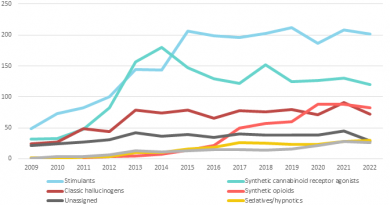UNODC EWA: New synthetic cannabinoid receptor agonists increase structural diversity
VIENNA, Austria – February 2022: As of December 2021, a total of 1,124 unique new psychoactive substances have been reported to the UNODC Early Warning Advisory on NPS (EWA). Stimulants continue to constitute the largest group of NPS at 34 per cent, followed by synthetic cannabinoid receptor agonists (SCRAs) (29 per cent) and classic hallucinogens (14 per cent) (see Figure 1). Synthetic opioids saw a significant increase between 2015 and 2021 and currently represent the fourth-largest group.
Figure 1: New psychoactive substances by effect group, up to December 2021*

Source: UNODC Early Warning Advisory on New Psychoactive Substances, 2022.
Note: *Data collection for 2021 is not completed yet and therefore subject to change. 134 reporter countries and territories were included.
Since 2009, a total of 320 different synthetic cannabinoid receptor agonists have been reported to the UNODC EWA. The majority belong to the structural group of aminoalkylindoles and aminoalkylindazoles (see Figure 2). In 2021, based on preliminary data, four different structural groups of SCRAs were reported. The emergence of three SCRAs belonging to the structural group of isatin acylhydrazones in 2021 (5F-BZO-POXIZID, BZO-4en-POXIZID and BZO-CHMOXIZID), a group that first emerged in 2015 with only one substance (MDA-19; BZO-HEXOXIZID) reported until 2021, broadens the structural diversity of SCRAs currently on the illicit drug market.
Figure 2: Emergence of synthetic cannabinoid receptor agonists reported for the first time, by structural group, 2009-2021*

Source: UNODC Early Warning Advisory on New Psychoactive Substances, 2022.
Note: *Data collection for 2021 is not completed yet and therefore subject to change. The group of miscellaneous includes SCRAs that comprise of less abundant structural subclasses or have unique structures on their own.
Since 2014, 19 synthetic cannabinoid receptor agonists have been included in the Convention on Psychotropic Substances of 1971. Most of them belong to the structural groups of aminoalkylindazoles and aminoalkylindoles. Their timely identification has allowed to reduce the time between the emergence and scheduling of substances that pose a potential harm to public health. As structurally diverse SCRAs continue to emerge, it remains crucial for laboratory analysts to keep abreast of current trends and for national legislative frameworks to consider the emergence of new substances and structural classes that may not be covered by existing legislation.
For more information, please see:
UNODC, Recommended methods for the Identification and Analysis of Synthetic Cannabinoid Receptor Agonists in Seized Materials (September 2020).
UNODC, “Regional diversity and the impact of scheduling on NPS trends”, Global SMART Update, vol. 25 (April 2021).
UNODC, June 2021 – UNODC: CND decision on international control of isotonitazene enters into force – remaining decisions will enter into force in December 2021, newsclip (June 2021).
Cayman Chemical, NPS Discovery/Center for Forensic Science Research and Education, New Systematic Naming for Synthetic Cannabinoid “MDA-19” and Its Related Analogues: BZO-HEXOXIZID, 5F-BZO-POXIZID, and BZO-POXIZID (August 2021).
Laboratory and Scientific Services Publications
SMART Publications




